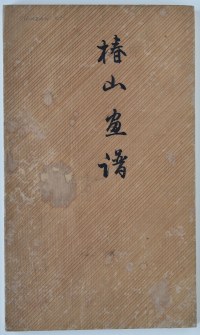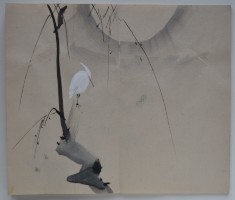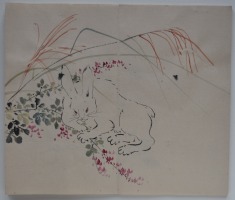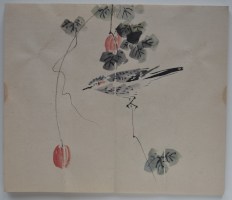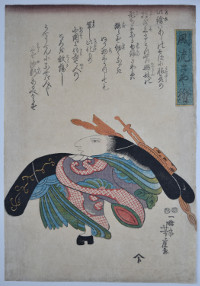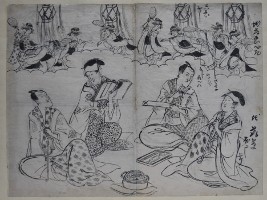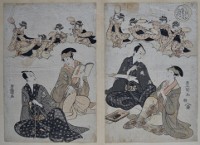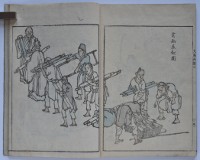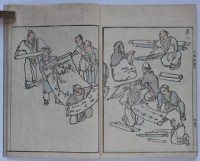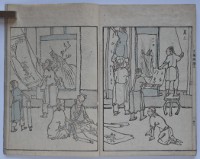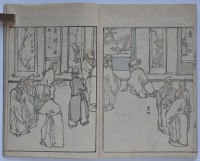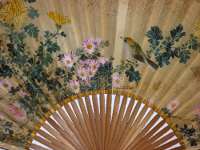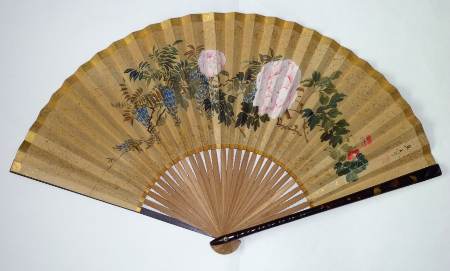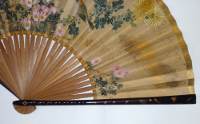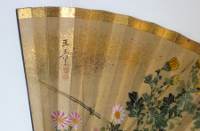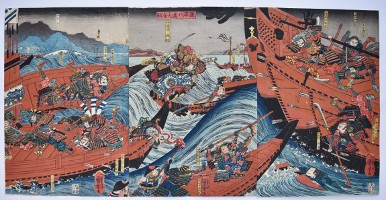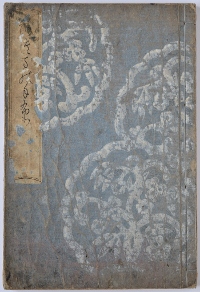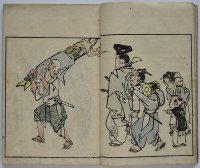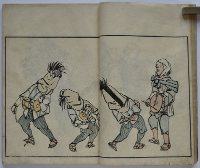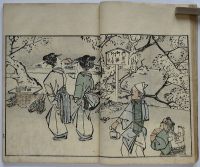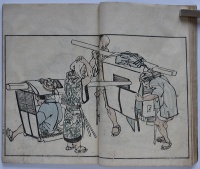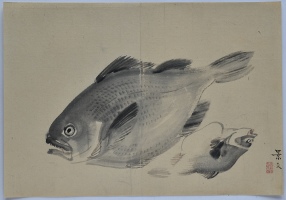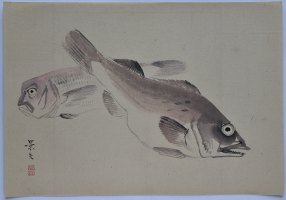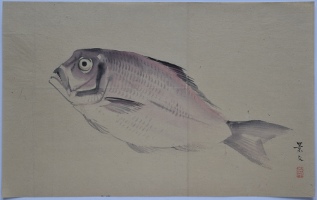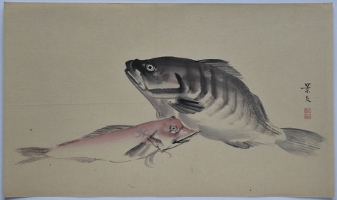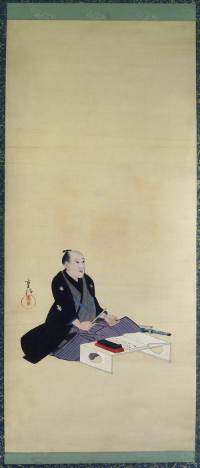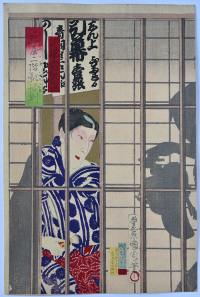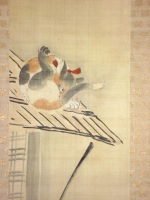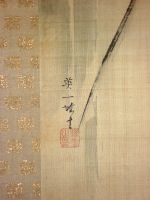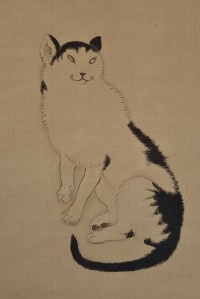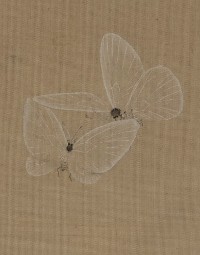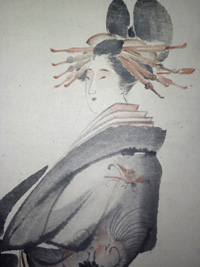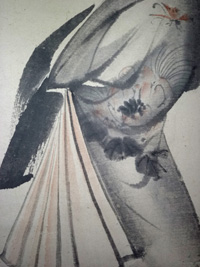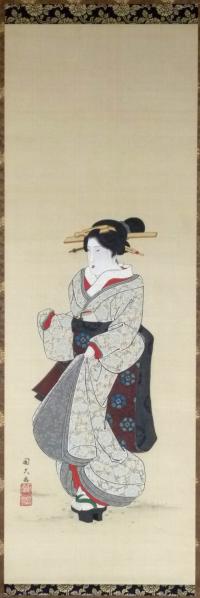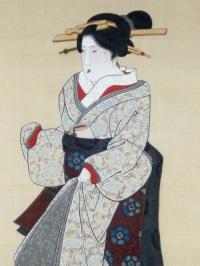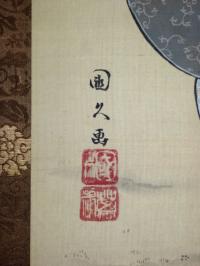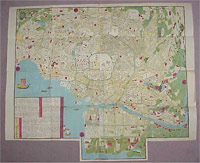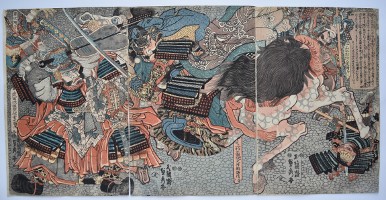/category/available/page/6/
Utagawa TOYOKUNI I (1769-1825)
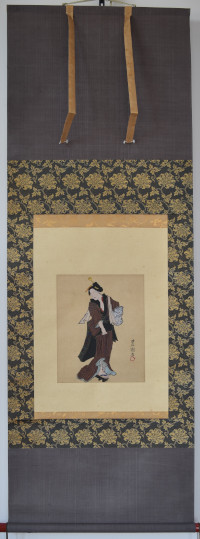
Click here to view image full size.
An original painting, sumi and colour on silk, 10.5 x 8.75 in; 26.7 x 22.2 cms. A beauty after a bath. Signed Toyokuni ga with his kakihan. In very good condition.
Status: Available
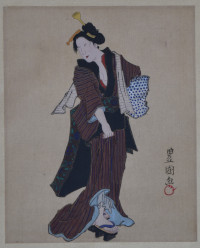
Click here to view image full size.
Totoya HOKKEI (1780-1850)

Click here to view image full size.
An original painting, full colour with gold outline to robe, 32 x 10.75 in; 81.3 x 27.3 cms, on silk. Shows a beauty erotically biting on her hand towel (tenugui) while on the way to a public bath house. This gesture represented deep emotion. Hokkei was one of Hokusai’s earliest and best pupils who not only produced paintings but illustrated books and is especially known for his fine surimono. Illustrated in Nihon ukiyoe hakubutsukan, ed., Nikuhitsu ukiyoe senshu gekan (Selected Painting of Ukiyo-e, second vol.) (Tokyo: Gakushu kenkyusha , 1985). Plate 188. In very good condition with an interesting shibori (tie-dyed) mount, cleverly echoing the pattern on the material she holds. Signed Hokkei ga with Hokkei seal.
Status: Available
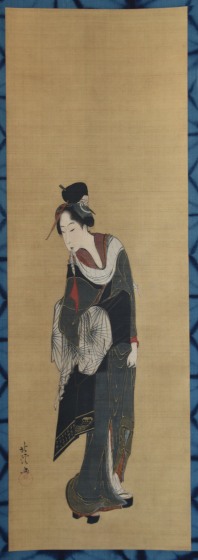
Click here to view image full size.
Tsubaki CHINZAN (1801-1854)
Click here to view image full size.
An original painting album, 11 x 13 in; 28 x 33 cms (folded out). Chinzan, a Nanga painter, was Watanabe Kazan’s best pupil. The sketchbook has 25 extremely abbreviated sketches using minimal brushstrokes.
Status: Available
Katsukawa SHUNKO (1743-1812)
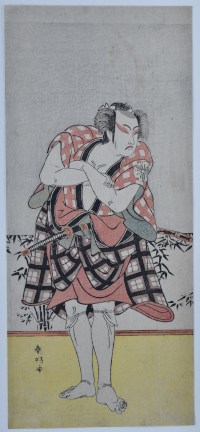
Click here to view image full size.
The actor Matsumoto Koshiro II, arms crossed, in a defiant stance. Shunko had a minor stroke at the age of 45 and subsequently had to work with his left hand using the go of Sahitsusai, “Studio of the Left-handed Brush.” Published c 1771-1772.
Very good impression, colour and condition. Signed Shunko ga.
Status: Available
Utagawa KUNIYOSHI (1797-1861)
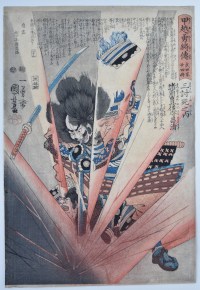
Click here to view image full size.
The general Morozumi Masakiyo, Lord of Bungo and a retainer of the Takeda Clan (Shingen of Kai Province) in a battle with the Uesugi Clan (Kenshin of Echigo Province), The wars taking place between 1553 and 1563. From a set Koetsu yusho den, “Stories of Courageous Generals of the Provinces of Echigo and Kai.” Masakiyo is shown committing suicide by inserting his sword into his mouth while being blown up by a land-mine. As with so much in Japan, the land-mine originated in China from early times. Published by Sumiyoshiya Masagoro, c 1848-9. One of the “three great deaths” of these wars.
Very good impression with extensive sprayed pigment around the exploding mine. Slight fading, otherwise very good condition. Signed Ichiyusai Kuniyoshi ga.
Status: Available
Toyohara KUNICHIKA (1835-1900)
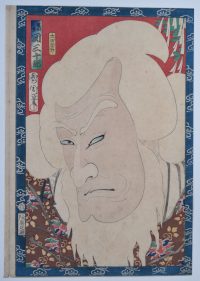
Click here to view image full size.
The actor Seki Sanjuro III as Saruta Hiko in the play Yoinakatomi Kiyome no mikagura staged at the Ichimura-za Theatre 8/1869. From a set of at least 22 prints published by Gusokuya Kahei, 1869. Kunichika was a hack artist who nevertheless produced some fine triptychs (horizontal and vertical) and this fine set of actor bust portaits.
Fine impression with extensive blind-printing on the beard and hair. Fine colour. Slight foxing and crease in left margin, otherwise very good condition. Signed Kunichika hitsu.
Status: Available
Utagawa KUNIYOSHI (1797-1861)
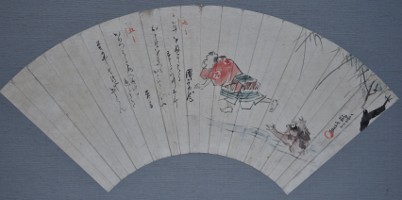
Click here to view image full size.
An original fan painting, 6.5 x 17.5 in; 16.5 x 44.5 cms. Sumi and colour on treated paper. Shows a kappa appearing from the Sumidagawa and terrifying a man who runs for his life. Kappa were amphibious creatures found in rivers and ponds. Their bodies were covered with a horny carapace like a tortoise, with scaly legs and four frog-like webbed feet. They loved to wrestle and were known to attack humans – especially children, and horses. However, they could be tricked as they were very polite. If you bowed to a kappa he invariably bowed back, and as their source of power lay in a pool of water contained in a depression in the head, this would be spilt and they became immobilized. Laid around the edge onto Japanese board with the ribmarks evident as it has been dismounted from an ogi or folding fan. Signed Ichiyusai Kuniyoshi ga with hand-painted toshidama seal. Good condition.
Status: Available
Mori SOSEN (1747-1821)
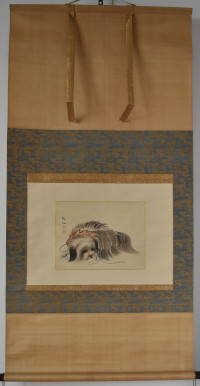
Click here to view image full size.
An original painting, sumi and light colour on silk, image size 8 x 10.75 in; 20.5 x 27.5 cms. His life is not well documented but he is known to have studied under the Kano artist Yamamoto Joshunsai (? -1781) before being drawn into Mauyama Okyo’s (1735-1795) artistic circle and his style is more Shijo than anything else. His animal paintings were evidently highly valued by Okyo. He was an immediate favourite with eastern collectors because of his monkey paintings at which he excelled, although he was more versatile than literature implies and highly accomplished at drawing other animals (as here). But his images of monkeys take precedence and he is considered the pre-eminent painter, east or west, on this subject. It is alleged that he lived in the woods for three years eating fruit and nuts to study the monkeys and other animals and is also supposed to have had a cage of monkeys at the back of his house to better observe them.
Shows a Japanese Chin. These small dogs are supposed to have been introduced to the Japanese court from China early on but their distinctive features were developed in Japan. Signed Sosen with seals Shusho. In very good condition.
Status: Available
Kawamata TSUNEYUKI (1677-c1744)
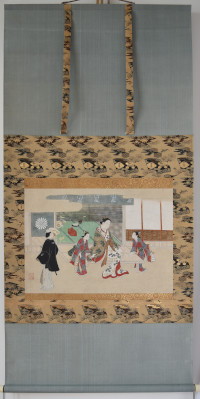
Click here to view image full size.
An original painting, full colour on paper, 14.5 x 21 in; 35.5 x 53.5 cms. The founder of the Kawamata School. (A pupil was Kawamata Tsunemasa.) Little is known of his life and there are few paintings: A group were in Christies NY, 27/10/1998, lots 40, 42, 44, 45; and there are examples in the BM, reg. no 1931,1116,0.2, the MET, acc. no 36.100.90, and the National Museum of Asian Art, Smithsonian, acc. no. F1898.118. Shows a courtesan with her attendants outside a teahouse being admired by a passing samurai. Areas of careful restoration, but in generally good condition. Sealed Tsuneyuki.
Status: Available

Click here to view image full size.
Nagasawa ROSETSU (1754-1799)
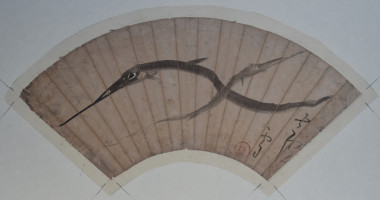
Click here to view image full size.
An original fan painting, sumi on treated paper, 17 x 6.25 in; 43 x 16 cms. Shows two needlefish (family Belonidae).Rosetsu is considered one of the most important artists of the late Edo period but little is known of his short life – he died at forty-five, apart from the fact that he studied and was one of the top disciples of Maruyama Okyo. He is labelled an “eccentric” painter as he defies easy classification. His brushwork is a tour de force and he is known for his expressive depictions of animals. Signed Rosetsu with his Gyo (fish) seal. Framed and glazed with the fan mounted onto Japanese paper. Good condition, apart from the obvious fan folds.
Status: Available
Utagawa KUNIYOSHI (1797-1861)
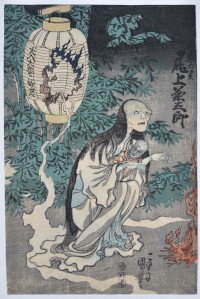
Click here to view image full size.
The actor Onoye Kikugoro III as the ghost of Oiwa from a production of Yotsuya kaidan at the Morita Theatre, 1836. Probably the most famous Japanese ghost story. It was adapted by the playwright Tsuruya Nanboku IV for his friend Kikugoro in 1825. The left panel of a diptych (the right panel being boring and usually ignored). A scene on Snake Mountain showing Oiwa, disfigured by poison, emerging from a burning lantern to haunt her husband, Tamiya Lemon, who had murdered her father. Published by Kawaguchi-ya Chozo, 1836.
Very good impression, colour and condition. Signed Ichiyusai Kuniyoshi ga.
Status: Available
Kawanabe KYOSAI (1831-1889)
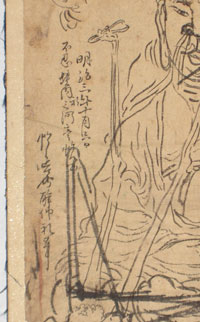
Click here to view image full size.
An important collection of original drawings by Kyosai laid into two accordion albums, opening horizontally, 13.5 x 10 inches. Approx 157 drawings ( one signed and sealed; one signed and dated [ 6th October Meiji 3,1870 ]; and one signed ). After the date is the place: Shinobazu keidai Mikawatei, the garden of a temple ( Bentendo Hall ( ?) at Shinobazu pond, Ueno Park; Mikawatei being a restaurant. And the signature: Seisei Kyosai sui butsu rei hitsu, the drawing of Amida painted when drunk. Some drawings are from life, others seem to be memory drawings of his work, but most are preliminary ideas for books, prints or paintings. Many of Kyosai’s favourite subjects are represented including: skeletons, onis and cats. Drawings on this scale, spontaneous and with no need to impress, give a better insight into the mind of an artist, and on almost every page Kyosai’s humour shines through. Of particular delight are a group of drawings showing men on horseback playing some Japanese variation of polo, and a sheet recording new-born, still blind rats.
Status: Available
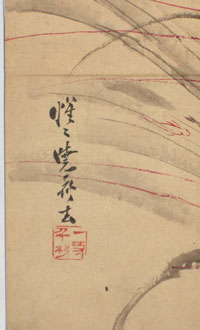
Click here to view image full size.
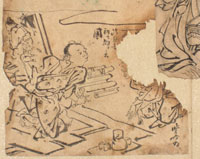
Click here to view image full size.
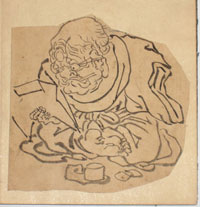
Click here to view image full size.
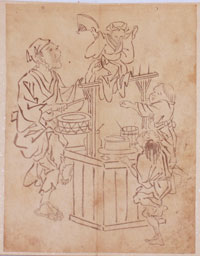
Click here to view image full size.

Click here to view image full size.
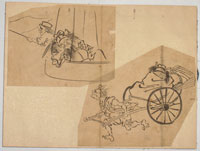
Click here to view image full size.
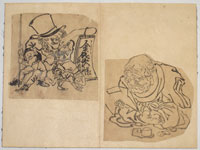
Click here to view image full size.

Click here to view image full size.
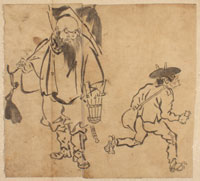
Click here to view image full size.
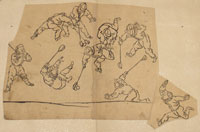
Click here to view image full size.
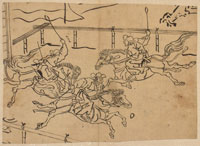
Click here to view image full size.
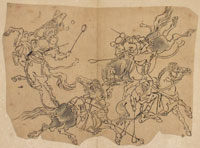
Click here to view image full size.
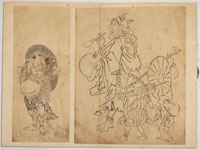
Click here to view image full size.
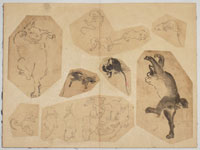
Click here to view image full size.
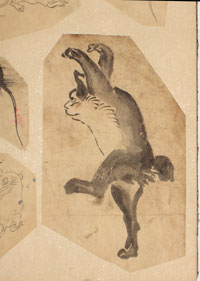
Click here to view image full size.
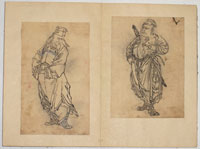
Click here to view image full size.
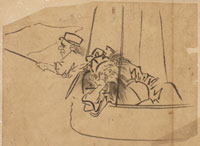
Click here to view image full size.
Imao KEINEN (1845-1924)

Click here to view image full size.
An original painting, sumi on paper, image size 54 x 19.5 in; 137 x 49.5 cms. A pupil of Umegawa Tokyo and Suzuki Hyakunen. Keinen was an important figure in Kyoto art circles and considered the pre-eminent kachoga (bird and flower) artist at the end of the 19th century winning many prizes at home and abroad. Best known for his 4 volume Keinen kacho gafu, “Album of Bird and Flower Pictures by Keinen” published 1891-2. Shows two peacocks standing on a rocky outcrop. Peacocks were a popular subject for artists who could display their prowess at painting, the results often being sumptuously rendered. However, Keinen opts for a freer style in sumi only. Keinen was also known as a keen horticulturist and a bonsai expert. Original kiri wood box inscribed by him on the inside of the lid and guaranteeing the painting as being genuine. Outer lacquer box. In very good condition. Signed Keinen with seal.
Status: Available
Ichiunsai KUNIHISA (1832-1891)

Click here to view image full size.
An original painting, full colour on paper with the black waistband heavily lacquered, image size 48 x 11 in; 122 x 28 cms. Shows a young beauty carrying a box. She wears an apron and has a towel slung over her shoulder, so is presumably an assistant in a kitchen or bathhouse or similar establishment. The narrow format enhances her natural elegance. Kunihisa was the pupil and son-in-law of Kunisada. Some repaired wormage, otherwise good condition. Signed Kunihisa ga with two indistinct seals.
Status: Available

Click here to view image full size.
Utagawa TOYOKUNI I (1769-1825)
An original drawing by the first Toyokuni. An hanshita-e diptych for a published set of triptychs with title: Yakusha juni tsuki, “Actors in the Twelve Months.” Shows the actors (from the left) Bando Mitsugoro III holding a pipe; Iwai Hanshiro V with an open book; Nakamura Utaemon III about to write a poem; and Segawa Roko IV with another pipe. They are compared to the months of the year, in this case July, the month of the Bon Odori festival and are also a parody of the Six Immortal Poets. The print published by Yamashiroya Toemon (active c. 1801-1817). In fact this set was published Spring, Bunka 6 (1809). Sumi on thin paper laid around edges onto another sheet. Some pentimenti and also shows the initial hurried under-drawing and with annotations for the finished print. Sold together with the two published sheets which shows the lanterns removed at top, the brazier bottom centre and other minor changes. In indifferent condition. An illustrated example of this complete triptych is in the Austrian Museum of Applied Arts.
The print signed Toyokuni ga. Original hanshita-e by Toyokuni I are extremely rare. Sold “as is” with all imperfections.
Status: Available
Utagawa HIROSHIGE (1797-1858)
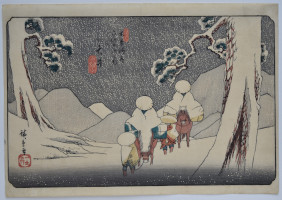
Click here to view image full size.
Oi, a suburb of present day Ena City, is in the southern foothills of the central mountain range now known as the Japan Alps. Shows a group of travellers heavily protected against the snow and cold. From Kisokaido rokujukyutsugi no uchi, “Sixty-Nine Stations of the Kisokaido.” The set of seventy prints was started by Eisen and published by Hoeido in 1835, but in 1837 Hiroshige took over and completed the series with the publisher Iseya Rihei (Kinjudo). One of Hiroshige’s most famous designs.
Very good impression and colour. Imperceptible centre fold, otherwise very good condition. Signed Hiroshige ga.
Status: Available
Utagawa KUNISADA II (1823-1880)
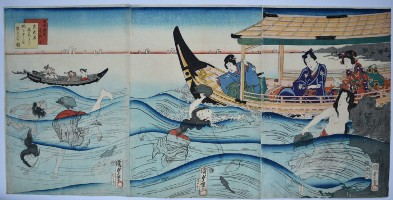
Click here to view image full size.
A triptych showing Prince Genji in a boat with attendant page and a lady watching female awabi (abalone) divers called ama. These women were a great curiosity for the public and seen as rather risqué characters. Prince Genji was the protagonist of Murasaki Shikibu’s Heian-era novel The Tale of Genji. He was the second son of the emperor, and relegated to civilian life. Published 1865 by Maruya Kyushiro.
Very good impression and colour. Slight edge soil, otherwise very good condition. Signed Kunisada hitsu.
Status: Available
Kawamura BUMPO (1779-1821)
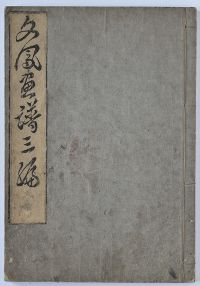
Click here to view image full size.
I volume complete Bumpo gafu (Sampen), “Album of Drawings by Bumpo” (3rd Series”). Original light grey covers with burnished pattern. Original title slip. Preface 3 pp., with 18 double-page and 32 single-page illustrations in sumi and light colour numbered 1 – 35. Colophon dated Bunka 10 (1813).(First edition.) Signed Bumpo with publishers Kawachiya Kihei and Yoshidaya Shimbei. Fine impressions. Very good condition with no thumbing to corners.
Status: Available
Hosoda EISHI (1736-1829)

Click here to view image full size.
An original painting, sumi and colour on silk, 33.25 x 12 in; 84.5 x 30.5 cms. Shows a parading oiran, a high class courtesan, beneath falling cherry blossom. A parade was held every April in the Yoshiwara under the spring cherry blossom. Her costume is decorated with a large golden koi swimming amongst water weeds. An elegant and refined painting of great delicacy typical of this painter who was of unusually high rank for an Ukiyo-e artist. His prints – usually of beauties – are equally elegant. He also had a considerable number of pupils, including Eisho, Eiri and Eisui who produced some exceptional compositions. Probably painted around 1795-1804.
Mount with some minor damage; painted area in very good condition. Signed Chobunsai Eishi hitsu with Eishi seal.
Status: Available

Click here to view image full size.
Toyohara KUNICHIKA (1835-1900)
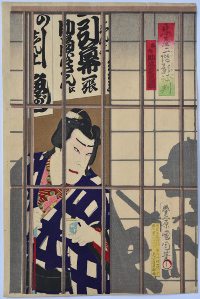
Click here to view image full size.
The actor Suketakaya Takasuke IV as Sakuramaru from a fine set of prints showing actors glimpsed through their dressing room sliding doors, prior to going on stage. Their figures partly silhouetted as are their assistants, here aiding the actor with his sword. From a set Gakuya nikai kage no hyoban, “Popularity of the Upstairs Dressing Room.” The set published by Takagawa Fusajiro, 1883.
Fine impression, colour and condition. Full size. Signed Toyohara Kunichika hitsu.
Status: Available
Toyohara KUNICHIKA (1835-1900)
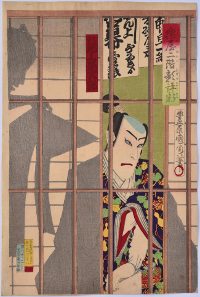
Click here to view image full size.
The actor Onoe Kikugoro V as Hisayoshi from a fine set of prints showing actors glimpsed through their dressing room sliding doors, prior to going on stage. Their figures partly silhouetted as are their assistants, here aiding the actor with his costume. From a set Gakuya nikai kage no hyoban, “Popularity of the Upstairs Dressing Room.” The set published by Takagawa Fusajiro, 1883.
Fine impression, colour and condition. Full size. Signed Toyohara Kunichika hitsu.
Status: Available
Utagawa KUNISADA (1786-1864)
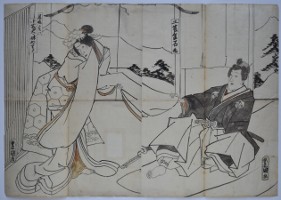
Click here to view image full size.
An original hanshita-e (preparatory drawing) for a published diptych showing, on the left, the actor Onoe Kikujiro II as Tatsuhime – in reality Yawata, the younger sister of Kotoda. On the right is Iwai Kumesaburo III as Kudo Kanaishimaru. The play is Matsu icho Tsurukame Soga performed at the Nakamura-ya theatre, 1/1854. The publisher of the print was Sanoki. These first drafts by the artist themselves survive because a more detailed drawing was needed by the blockcutter, and this was normally given to an assistant to execute. Or the drawing was never taken up by the publisher, for whatever reason. Sumi and touches of red. Signed Toyokuni ga on both sheets. Sold “as is” with all imperfections.
Status: Available
Kawabata GYOKUSHO (1842-1913)
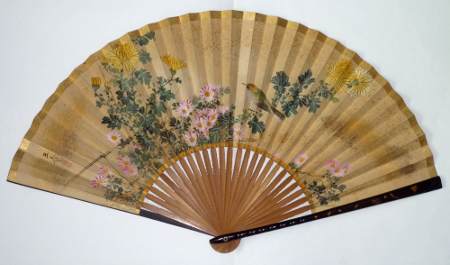
Click here to view image full size.
An original painted fan. On one side a bird amongst flowers and the reverse also with flowers. A leading figure in Tokyo art circles and the last great representative of the Shijo school. In exceptional condition with extensive gold leaf. Signed Gyokusho with seals Shibun on both sides.
Full colour on silk, each panel 39.75 x 25 in; 101 x 63.5 cms. Extremely good condition. Signed Kinzaburo Yoshitoshi ga with blurred seal but reading Go Kaisai. Extremely rare.
Status: Available
Utagawa KUNIYOSHI (1797-1861)
Click here to view image full size.
Gempei Yashima o-kassen, the great battle of Yashima in 1184. Shows Yoshitsune’s famous “eight-boat leap” (centre), Noritsune (left), and Benkei on the large boat (right). Published by Kawaguchiya Uhei, c. 1839-41.
Very good impression and colour. Edge repair top left sheet, otherwise very good condition. Signed Ichiyusai Kuniyoshi ga.
Status: Available
Onishi CHINNEN (1792-1851)
Click here to view image full size.
One volume complete Azuma no teburi, “Customs of the Eastern Capital”. Published Bunsei 12 (1829). Original covers, light blue-grey with silver stencilled decoration. Original title slip (damaged). Inside front cover title Taihei Uzo (the original title). Artist: Chinnen, and publisher Sonando. 25 double page illustrations showing the inhabitants of the capital going about their daily pursuits. Inside back cover: Colophon, dated Bunsei 12 (1829) and publishers Kobayashi Shimbei and Osakaya Gembei. Slight repared wormage and minor marks, but generally a nice copy of a fine shijo book.
Status: Available
Matsumura KEIBUN (1779-1843)
Click here to view image full size.
A shijo brush drawing of a seabream and a lumpfish (?). One of Kyoto’s leading artists. Noted for his painting from nature. He studied with his older brother Matsumura Goshun as well as Maruyama Okyo. Sumi and light colour on paper, 10 x 14.75 in; 25.4 x 37.4 cms.
In good condition. Signed and sealed Keibun.
Status: Available
Matsumura KEIBUN (1779-1843)
Click here to view image full size.
A shijo brush drawing of a white horsehead and an acropomatidae (?). One of Kyoto’s leading artists. Noted for his painting from nature. He studied with his older brother Matsumura Goshun as well as Maruyama Okyo. Sumi and light colour on paper, 10.5 x 15 in; 26.7 x 38.1 cms.
In good condition. Signed and sealed Keibun.
Status: Available
Matsumura KEIBUN (1779-1843)
Click here to view image full size.
A shijo brush drawing of a red seabream. One of Kyoto’s leading artists. Noted for his paintings from nature. He studied with his older brother Matsumura Goshun as well as Maruyama Okyo. Sumi and light colour on paper, 10.5 x 17 in; 26.7 x 43.2 cms.
In good condition. Signed and sealed Keibun.
Status: Available
Matsumura KEIBUN (1779-1843)
Click here to view image full size.
A shijo brush drawing of a gurnard and a snapper (?). One of Kyoto’s leading artists. Noted for his painting from nature. He studied with his older brother Matsumura Goshun as well as Maruyama Okyo. Sumi and light colour on paper, 10.5 x 17.75 in; 26.7 x 45.1 cms.
In good condition. Signed and sealed Keibun.
Status: Available
Yanagawa SHIGENOBU (1787-1833)
Click here to view image full size.
An original painting by this artist who was the pupil and then son-in-law of Hokusai. He was given the name Yanagawa (from his residence in the Honjo district of Edo) to distinguish him from other Shigenobu artists. A good book illustrator and surimono designer. He designed the first square surimono in Osaka in 1822, inspiring others to follow. His paintings are rare. Shows a portrait of the Japanese scholar and writer Ishikawa Masamochi (1754-1830). The fifth son of Ishikawa Toyonobu, he was a renowned kyoka poet and Gesaku writer (playful, mocking works), including The Magical Carpenter of Japan. An important figure in kyoka/surimono circles. Known as Rokujuen (Yadao no Meshimori). His family crest is seen on his kimono and he sits before a low desk ready to write. A high quality painting, sumi and colour on silk, 29 x 12.5 in.; 73.6 x 31.8 cms. Several small backed wormholes at bottom, otherwise very good condition. Would benefit from being remounted.
Signed Shigenobu with seal Yanagawa.
Status: Available
Toyohara KUNICHIKA (1835-1900)
Click here to view image full size.
The actor Onoe Taganojo II from a fine set of prints showing actors glimpsed through their dressing room sliding doors, prior to going on stage. Their figures partly silhouetted as are their assistants, here aiding the actor with his headpiece. From a set Gakuya nikai kage no hyoban, “Popularity of the Upstairs Dressing Room.” The set published by Takagawa Fusajiro, 1883.
Fine impression, colour and condition. Full size. Signed Toyohara Kunichika hitsu.
Status: Available
ANONYMOUS (Late 18th century)
Click here to view image full size.
An Uki-e, “floating picture” painting showing an interior with a puppet performance taking place. A puppeteer manipulates a female puppet in the centre, behind him two gidayu narrators and a shamisen player. A male puppet is being held behind a screen. Ladies behind a screen at right enjoy the drama. In fact, a male individual at the back seems overcome by emotion with a hanky to his face. The architecture is represented using one-point perspective, a style which made its way to Japan in the 1740’s from the West via China. (Interestingly the artist has got the perspective wrong on the screen at right.) This genre of painting – invariably unsigned – always shows interior or semi-interior views with banquets or, as here, puppet performances. Full colour on paper, 17 x 23 in; 43.2 x 58.5 cms. Minor marks, although good condition for this kind of painting.
Status:
Available
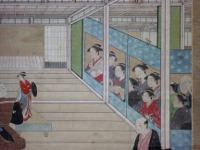
Click here to view image full size.
Hanabusa ITCHO ( 1670-1724 )
Click here to view image full size.
An original painting showing a cat cleaning itself on a precarious tea-house roof. A charming study and typical of his work which often depicted the commonplace and comical sides to life. Itcho first studied the Kano tradition, perhaps under Kano Yasunobu ( 1618-1685 ). He was also known in poetry circles. However, like a lot of other artists of the time, he ran foul of the authorities and was exiled for 12 years in Miyakejima. On his return in 1709 he adopted the name Hanabusa Itcho and focused on ukiyo-e painting following in the footsteps of Moronobu but with more of a common touch. Ink and colour on silk. Image size 40.5 x 9.25 in; 113 x 23.5 cms.
Signed Hanabusa Itcho with seal Nobuka no in. Box inscription Hanabusa Itcho Okujo no neko. Painted c 1710-20. In very good condition. Copies of Itcho paintings and drawings abound, partly because of his popularity and importance, but also because his staccato-like style and often simple subjects lend themselves to plagiarism. This lovely and unusual composition shows Itcho at his best. See also: Hanabusa Itcho ten ( exhibition catalogue ), Itabashi Museum of Art, 1984 ( see pl. 20 for the identical seal and very similar signature ); M. Murase, Japanese Art: Selections from the Mary and Jackson Burke Collection, Metropolitan Museum of Art, 1975, cat. No. 89; and for a description of his life: T. Koyasahi, Life of Hanabusa Itcho, Kokka, vol. 920, 1968, 00. 5-10.
Status: Available
Mori TETSUZAN (1775-1841)
Click here to view image full size.
A seated cat with butterflies above. Tetsuzan, the adopted son of Mori Sosen, was known for his animal paintings and was one of the ten best pupils of Okyo. Good condition.
Sumi and colour on beige silk. Image size 38.25 x 14.5 inches. Mounted on brown damask with ivory rollers. Signed Tetsuzan with seal Shushin.
Status: Available
Oku BUMMEI (?-1813)
Click here to view image full size.
A Maruyama school artist and “One of the ten most notable pupils of Okyo.” A contributor to the anthology Keijo gaen of 1814. Shows a strolling courtesan composed of almost limpid brush strokes creating an ethereal image of the floating world. Sumi and light brown-red on paper, 41.25 x 11.75 in; 104.75 x 29.75 cms. Mount and painting in very good condition. Signed Bummei and undecipherable seal.
Status: Available
Ichiunsai KUNIHISA II (1832-1891)
Click here to view image full size.
A fine work of the artist, c 1850s. The pupil and son-in-law of Kunisada. A beauty promenading. Sumi and full colour on silk. Image size 34 x 11.75 in; 86.5 x 29.5 cms. Fine condition. New mount and box. Signed Kunihisa ga. Seals unread.
Status: Available
Utagawa HIROSHIGE (1797-1858)
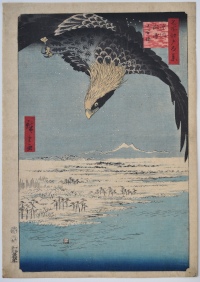
Click here to view image full size.
Fukagawa, Suzaki, Juman-tsubo, “One Hundred Thousand Tsubo Plain, Suzaki, Fukagawa” from Mesho Edo hyakkei, “Hundred Famous Views of Edo.” The set published by Uoya Eikichi between 1856 and 1859 (this being 1857). An eagle hovers over the snowy coastal plain, Mt. Tsukuba and the Chiba mountains in the distance. Collectors at the beginning of the 20th century considered this the pre-eminent design from the set. Since then Ohashi has replaced it.
Very good impression and colour. Slight edge soil, otherwise very good condition. Signed Hiroshige ga.
Status: Sold
Utagawa SADAHIDE (1807-1873)
Click here to view image full size.
An exceptionally rare triptych showing the great battle between Takeda Shingen (left) and Uesugi Kenshin (right) during the fourth (of five) Kawanakajima battles. Kenshin lunges with his sword but is parried by Shingen using his iron war fan (gunbai). These skirmishes took place in the mid. 16th century. I can, at the moment, only locate one damaged impression of this fine design. Published 1846 by Tsujiokaya Bunsuke.
Very good impression, colour and condition. Full size. Signed Gyokuransai Sadahide ga.
Status: Sold
